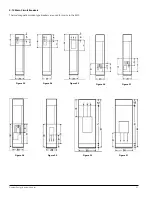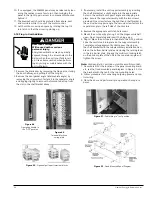
3. The handle assembly must be adjusted to perform the fol-
lowing functions:
Circuit Breaker
Disconnect Switch
Unit must turn ON
Unit must turn ON
Unit must turn OFF
Unit must turn OFF
Unit must indicate TRIP
Unit must RESET
4. Operate the handle from the ON position to the OFF
position and circuit breaker or disconnect switch will turn
OFF.
5. Return the handle to the ON position and the circuit breaker
or disconnect switch will turn ON. If it does not, rotate the
sleeve slightly clockwise and try again. Repeat this step
until the handle assembly turns the unit ON. Then, repeat
step 4.
6* Once steps 4 and 5 have been satisfactorily completed, the
adjustment for the disconnect switch will have been
completed. Tighten the hex nut against the sleeve to lock in
the adjustment. The following steps will now only pertain to
circuit breakers.
7. Trip the circuit breaker and the handle should move to a
position midway between the ON and reset positions.
Circuit breakers from different manufacturers require
different methods to trip them. One can be tripped by
rotating a red button, another by passing a high current at
low voltage through one of the poles. (The defeater
mechanism should engage.)
8* Now move the handle down past the OFF position to reset
the circuit breaker. If the circuit breaker resets and can be
returned to the ON position by the handle, the adjustment
has been completed and the hex nut should be tightened
against the sleeve. If the circuit breaker does not reset, turn
the sleeve counterclockwise slightly and try again. Repeat
this step until the breaker resets. Then repeat steps 4-8 to
verify that the previous adjustments have not been
adversely effected.
9. In the case of both the circuit breaker and disconnect
switch, the adjustment should be such they turn on with
the knob no closer the 1/8. away from the escutcheon.
*Note: Always use two wrenches when loosening, adjusting,
or tightening the adjustable link rod. One wrench adjusts
the hex sleeve while the second wrench holds the hex nut.
A provision is made for Qualified Persons to defeat the
dooroperator interlock when the handle is in the .ON.position.
This is
accomplished by turning the defeater screw counterclockwise
approximately 1/8 turn until the door is released. It is not nec-
essary to operate the defeater screw to close the unit door.
Release the defeater screw and secure the 1/4 turn door fas-
teners.
This safety interlock also serves to prevent inadvertent closing
of the disconnect when the door is open. Authorized person-
nel may defeat the interlock in this situation by pushing down
the exposed interlock arm lever. This releases the interlock so
that the protective device may be turned “ON”.
Hazardous voltage.
Will cause death or serious personal
injury.
Disconnect power before working
on this equipment.
With disconnecting device in the “OFF” position, and the
unit door open, defeat the interlock by pushing the top of the
lever to the left and turn breaker “ON” and “OFF” several
times. If the disconnecting device fails to turn “ON” or if
operating resistance is experienced, turn protector “OFF”.
Withdraw the unit and inspect for misalignement of the
operator extension(s) or the driver. Make necessary adjust-
ments to correct any misalignment
.
Siemens Energy & Automation, Inc.
35
5.7 Adjustment Notes
No field adjustment to the door interlock mechanism should
be necessary under normal operating conditions. However,
should adjustment become necessary as a result of mechanical
damage or wear, the following procedure is recommended.










































